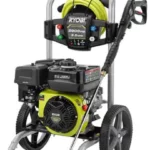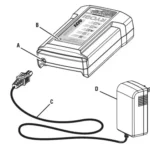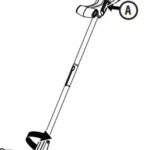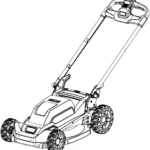
OPERATOR’S MANUAL
MANUEL D’UTILISATION
 http://register.ryobitools.com
http://register.ryobitools.com
18 VOLT OSCILLATING MULTI-TOOLOSCILLANT OUTIL
POLYVALENT 18 V OSCILANTE
MULTI-HERRAMIENTAS 18 V PCL430
INCLUDES: Multi-tool, General Purpose Plunge Cut Blade, Segment Saw Blade, Detail Sanding Backing Pad, Sandpaper, Operator’s Manual
![]() WARNING: To reduce the risk of injury, the user must read and understand the operator’s manual before using this product.
WARNING: To reduce the risk of injury, the user must read and understand the operator’s manual before using this product.
SAVE THIS MANUAL FOR FUTURE REFERENCE
GENERAL POWER TOOL SAFETY WARNINGS
![]() WARNING
WARNING
Read all safety warnings, instructions, illustrations and specifications provided with this power tool. Failure to follow all instructions listed below may result in electric shock, fire and/or serious injury.
Save all warnings and instructions for future reference.
The term “power tool” in the warnings refers to your mains-operated (corded) power tool or battery-operated (cordless) power tool.
WORK AREA SAFETY
- Keep work area clean and well-lit. Cluttered or dark areas invite accidents.
- Do not operate power tools in explosive atmospheres, such as in the presence of flammable liquids, gases or dust. Power tools create sparks that may ignite dust or fumes.
- Keep children and bystanders away while operating a power tool. Distractions can cause you to lose control.
ELECTRICAL SAFETY
- Power tool plugs must match the outlet. Never modify the plug in any way. Do not use any adapter plugs with earthed (grounded) power tools. Unmodified plugs and matching outlets will reduce risk of electric shock.
- Avoid body contact with earthed or grounded surfaces, such as pipes, radiators, ranges and refrigerators. There is an increased risk of electric shock if your body is earthed or grounded.
- Do not expose power tools to rain or wet conditions. Water entering a power tool will increase the risk of electric shock.
- Do not abuse the cord. Never use the cord for carrying, pulling or unplugging the power tool. Keep cord away from heat, oil, sharp edges or moving parts. Damaged or entangled cords increase the risk of electric shock.
- When operating a power tool outdoors, use an extension cord suitable for outdoor use. Use of a cord suitable for outdoor use reduces the risk of electric shock.
- If operating a power tool in a damp location is unavoidable, use a ground fault circuit interrupter (GFCI) protected supply. Use of a GFCI reduces the risk of electric shock.
- Use this product only with batteries and chargers listed in tool/appliance/battery pack/charger correlation supplement 987000-432.
PERSONAL SAFETY - Stay alert, watch what you are doing and use common sense when operating a power tool. Do not use a power tool while you are tired or under the influence of drugs,
alcohol or medication. A moment of inattention while operating power tools may result in serious personal injury. - Use personal protective equipment. Always wear eye protection. Protective equipment such as dust mask, non-skid safety shoes, hard hat or hearing protection used for appropriate conditions will reduce personal injuries.
- Prevent unintentional starting. Ensure the switch is in the off-position before connecting to power source and/or battery pack, picking up or carrying the tool.
Carrying power tools with your finger on the switch or energizing power tools that have the switch on invites accidents. - Remove any adjusting key or wrench before turning the power tool on. A wrench or a key left attached to a rotating part of the power tool may result in personal injury.
- Do not overreach. Keep proper footing and balance at all times. This enables better control of the power tool in unexpected situations.
- Dress properly. Do not wear loose clothing or jewelry. Keep your hair and clothing away from moving parts. Loose clothes, jewelry or long hair can be caught in moving parts.
- If devices are provided for the connection of dust extraction and collection facilities, ensure these are connected and properly used. Use of dust collection can reduce dust-related hazards.
- Do not let familiarity gained from frequent use of tools allow you to become complacent and ignore tool safety principles. A careless action can cause severe injury within a fraction of a second.
- Do not wear loose clothing or jewelry. Contain long hair. Loose clothes, jewelry, or long hair can be drawn into air vents.
- Do not use on a ladder or on unstable support. Stable footing on a solid surface enables better control of the power tool in unexpected situations.
![]() WARNING
WARNING
Read all safety warnings, instructions, illustrations and specifications provided with this power tool.
Failure to follow all instructions listed below may result in electric shock, fire and/or serious injury.
Save all warnings and instructions for future reference.
The term “power tool” in the warnings refers to your mains-operated (corded) power tool or battery-operated (cordless) power tool.
WORK AREA SAFETY
- Keep work area clean and well lit. Cluttered or dark areas invite accidents.
- Do not operate power tools in explosive atmospheres, such as in the presence of flammable liquids, gases or dust. Power tools create sparks that may ignite dust or fumes.
- Keep children and bystanders away while operating a power tool. Distractions can cause you to lose control.
ELECTRICAL SAFETY - Power tool plugs must match the outlet. Never modify the plug in any way. Do not use any adapter plugs with earthed (grounded) power tools. Unmodified plugs and
matching outlets will reduce risk of electric shock. - Avoid body contact with earthed or grounded surfaces, such as pipes, radiators, ranges and refrigerators. There is an increased risk of electric shock if your body is earthed or grounded.
- Do not expose power tools to rain or wet conditions. Water entering a power tool will increase the risk of electric shock.
- Do not abuse the cord. Never use the cord for carrying, pulling or unplugging the power tool. Keep cord away from heat, oil, sharp edges or moving parts. Damaged or entangled cords increase the risk of electric shock.
- When operating a power tool outdoors, use an extension cord suitable for outdoor use. The use of a cord suitable for outdoor use reduces the risk of electric shock.
- If operating a power tool in a damp location is unavoidable, use a ground fault circuit interrupter (GFCI) protected supply. The use of a GFCI reduces the risk of electric shock.
- Use this product only with batteries and chargers listed in tool/appliance/battery pack/charger correlation supplement987000-432.
PERSONAL SAFETY
- Stay alert, watch what you are doing and use common sense when operating a power tool. Do not use a power tool while you are tired or under the influence of drugs, alcohol or medication. A moment of inattention while operating power tools may result in serious personal injury.
- Use personal protective equipment. Always wear eye protection. Protective equipment such as dust masks, non-skid safety shoes, hard hat or hearing protection used for appropriate conditions will reduce personal injuries.
- Prevent unintentional starting. Ensure the switch is in the off-position before connecting to a power source and/or battery pack, picking up or carrying the tool. Carrying power tools with your finger on the switch or energizing power tools that have the switch on invites accidents.
- Remove any adjusting key or wrench before turning the power tool on. A wrench or a key left attached to a rotating part of the power tool may result in personal injury.
- Do not overreach. Keep proper footing and balance at all times. This enables better control of the power tool in unexpected situations.
- Dress properly. Do not wear loose clothing or jewelry. Keep your hair and clothing away from moving parts. Loose clothes, jewelry or long hair can be caught in moving parts.
- If devices are provided for the connection of dust extraction and collection facilities, ensure these are connected and properly used. Use of dust collection can reduce dust-related hazards.
- Do not let familiarity gained from frequent use of tools allow you to become complacent and ignore tool safety principles. A careless action can cause severe
injury within a fraction of a second. - Do not wear loose clothing or jewelry. Contain long hair. Loose clothes, jewelry, or long hair can be drawn into air vents.
- Do not use on a ladder or on unstable support. Stable footing on a solid surface enables better control of the power tool in unexpected situations.
POWER TOOL USE AND CARE - Do not force the power tool. Use the correct power tool for your application. The correct power tool will do the job better and safer at the rate for which it was designed.
- Do not use the power tool if the switch does not turn it on and off. Any power tool that cannot be controlled with the switch is dangerous and must be repaired.
- Disconnect the plug from the power source and/ or remove the battery pack, if detachable, from the power tool before making any adjustments, changing accessories, or storing power tools. Such preventive safety measures reduce the risk of starting the power tool accidentally.
- Store idle power tools out of the reach of children and do not allow persons unfamiliar with the power tool or these instructions to operate the power tool. Power tools are dangerous in the hands of untrained users.
- Maintain power tools and accessories. Check for misalignment or binding of moving parts, breakage of parts and any other condition that may affect the power tool’s operation. If damaged, have the power tool repaired before use. Many accidents are caused by poorly maintained power tools.
- Keep cutting tools sharp and clean. Properly maintained cutting tools with sharp cutting edges are less likely to bind and are easier to control.
- Use the power tool, accessories and tool bits etc. in accordance with these instructions, taking into account the working conditions and the work to be performed. Use of the power tool for operations different from those intended could result in a hazardous situation.
- Keep handles and grasping surfaces dry, clean and free from oil and grease. Slippery handles and grasping surfaces do not allow for safe handling and control of the tool in unexpected situations.
BATTERY TOOL USE AND CARE - Recharge only with the charger specified by the manufacturer. A charger that is suitable for one type of battery pack may create a risk of fire when used with another battery pack.
- Use power tools only with specifically designated battery packs. Use of any other battery packs may create a risk of injury and fire.
- When the battery pack is not in use, keep it away from other metal objects, like paper clips, coins, keys, nails, screws or other small metal objects, that can make a connection from one terminal to another. Shorting the battery terminals together may cause burns or a fire.
- Under abusive conditions, liquid may be ejected from the battery; avoid contact. If contact accidentally occurs, flush with water. If liquid contacts the eyes, additionally seek medical help. Liquid ejected from the battery may cause irritation or burns.
- Do not use a battery pack or tool that is damaged or modified. Damaged or modified batteries may exhibit unpredictable behavior resulting in fire, explosion or risk of injury.
- Do not expose a battery pack or tool to fire or excessive temperature. Exposure to fire or temperature above 265° F may cause an explosion.
- Follow all charging instructions and do not charge the battery pack or tool outside the temperature range specified in the instructions. Charging improperly or at temperatures outside the specified range may damage the battery and increase the risk of fire.
SERVICE - Have your power tool serviced by a qualified repair person using only identical replacement parts. This will ensure that the safety of the power tool is maintained.
- Never service damaged battery packs. Service of battery packs should only be performed by the manufacturer or authorized service providers.
MULTI-TOOL SAFETY WARNINGS
- Hold the power tool by insulated gripping surfaces, when performing an operation where the cutting accessory may contact hidden wiring. Cutting accessory contacting a “live” wire may make exposed metal parts of the power tool “live” and could give the operator an electric shock.
- Use clamps or another practical way to secure and support the workpiece to a stable platform. Holding the work by hand or against your body leaves it unstable and may lead to loss of control.
- Know your power tool. Read operator’s manual carefully. Learn its applications and limitations, as well as the specific potential hazards related to this power tool. Following this rule will reduce the risk of electric shock, fire, or serious injury.
- Always wear eye protection with side shields marked to comply with ANSI Z87.1 when assembling parts, operating the tool, or performing maintenance. Following this rule will reduce the risk of serious personal injury.
- Protect your lungs. Wear a face or dust mask if the operation is dusty. Following this rule will reduce the risk of serious personal injury.
- Protect your hearing. Wear hearing protection during extended periods of operation. Following this rule will reduce the risk of serious personal injury.
- Battery tools do not have to be plugged into an electrical outlet; therefore, they are always in operating condition. Be aware of possible hazards when not using your battery tool or when changing accessories. Following this rule will reduce the risk of electric shock, fire, or serious personal injury.
- Do not place battery tools or their batteries near fire or heat. This will reduce the risk of explosion and possibly injury.
- Do not crush, drop or damage the battery pack. Do not use a battery pack or charger that has been dropped or received a sharp blow. A damaged battery is subject to explosion. Properly dispose of a dropped or damaged battery immediately.
- Batteries can explode in the presence of a source of ignition, such as a pilot light. To reduce the risk of serious personal injury, never use any cordless product in the presence of an open flame. An exploded battery can propel debris and chemicals. If exposed, flush with water immediately.
- Do not charge the battery tool in a damp or wet location. Do not use, store, or charge battery packs or products in locations where the temperature is less than 50°F or more than 100°F. Do not store outside or in vehicles.
- Under extreme usage or temperature conditions, battery leakage may occur. If liquid comes in contact with your skin, wash immediately with soap and water. If liquid gets into your eyes, flush them with clean water for at least 10 minutes, then seek immediate medical attention. Following this rule will reduce the risk of serious personal injury.
- Save these instructions. Refer to them frequently and use them to instruct others who may use this tool. If you loan someone this tool, loan them these instructions also.
SYMBOLS
The following signal words and meanings are intended to explain the levels of risk associated with this product.
| SYMBOL | SIGNAL | MEANING |
| DANGER: | Indicates a hazardous situation, which, if not avoided, will result in death or serious injury. | |
| WARNING: | Indicates a hazardous situation, which, if not avoided, could result in death or serious injury. | |
| CAUTION: | Indicates a hazardous situation, that, if not avoided, may result in minor or moderate injury. | |
| NOTICE: | (Without Safety Alert Symbol) Indicates information considered important, but not related to a potential injury (e.g. messages relating to property damage). |
Some of the following symbols may be used on this product. Please study them and learn their meaning. Proper interpretation of these symbols will allow you to operate the
product better and safer.
| SYMBOL | NAME | DESIGNATION/EXPLANATION |
| Safety Alert | Indicates a potential personal injury hazard. | |
| Read Operator’s Manual | To reduce the risk of injury, user must read and understand operator’s manual before using this product. | |
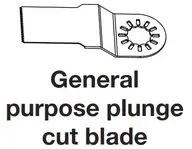 |
Eye Protection | Always wear eye protection with side shields marked to comply with ANSI Z87.1. |
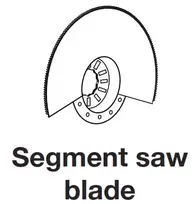 |
Wet Conditions Alert | Do not expose to rain or use in damp locations. |
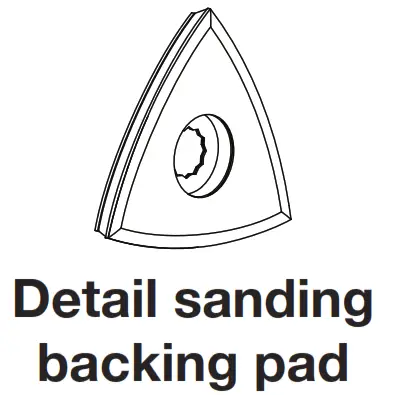 |
Recycle Symbol | This product uses lithium-ion (Li-ion) batteries. Local, state or federal laws may prohibit disposal of batteries in ordinary trash. Consult your local waste authority for information regarding available recycling and/or disposal options. |
| V | Volts | Voltage |
| min | Minutes | Time |
| Direct Current | Type or a characteristic of current | |
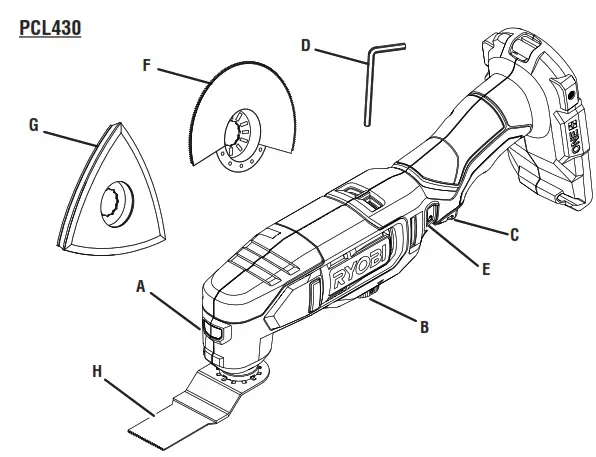 |
No Load Speed | Rotational speed, at no load |
| …/min | Per Minute | Revolutions, strokes, surface speed, oscillations etc., per minute |
FEATURES
PRODUCT SPECIFICATIONS
Speed (OPM) ………………………………………………………………………………………………………………………….. 10,000-20,000/min
Oscillation …………………………………………………………………………………………………………………………………………….3 degrees
ASSEMBLY
![]() WARNING:
WARNING:
Do not use this product if it is not completely assembled or if any parts appear to be missing or damaged. Use of a product that is not properly and completely assembled with damaged or missing parts could result in serious personal injury.
![]() WARNING:
WARNING:
Do not attempt to modify this product or create accessories or attachments not recommended for use with this product. Any such alteration or modification is misused and could result in a hazardous condition leading to possible serious personal injury.
If any parts are damaged or missing, please call 1-800-525-2579 for assistance.
OPERATION
![]() WARNING: Do not allow familiarity with this product to make you careless. Remember that a careless fraction of a second is sufficient to inflict serious injury.
WARNING: Do not allow familiarity with this product to make you careless. Remember that a careless fraction of a second is sufficient to inflict serious injury.
![]() WARNING: Always remove the battery pack from the tool when you are assembling parts, making adjustments, cleaning, or when not in use. Removing the battery pack will prevent accidental starting that could cause serious personal injury.
WARNING: Always remove the battery pack from the tool when you are assembling parts, making adjustments, cleaning, or when not in use. Removing the battery pack will prevent accidental starting that could cause serious personal injury.
![]() WARNING: Always wear eye protection with side shields marked to comply with ANSI Z87.1. Failure to do so could result in objects being thrown into your eyes and other possible serious injuries.
WARNING: Always wear eye protection with side shields marked to comply with ANSI Z87.1. Failure to do so could result in objects being thrown into your eyes and other possible serious injuries.
![]() WARNING: Do not use any attachments or accessories not recommended by the manufacturer of this product. The use of attachments or accessories not recommended can
WARNING: Do not use any attachments or accessories not recommended by the manufacturer of this product. The use of attachments or accessories not recommended can
result in serious personal injury.
APPLICATIONS
You may use this product for the purposes listed below:
- Straight cutting in wood, plastic, and thin metals
- Flush cutting in wood and drywall
- Sanding in corners and other hard-to-reach areas
- Scraping paint, varnish, and adhesive-backed coverings from surfaces.
THERMAL PROTECTIVE DEVICE
If the motor becomes overheated, the LED will flash and the motor will automatically cut off. If this happens, release the switch trigger and let the motor cool.
NOTE: The tool will not operate until the motor cools.
INSTALLING/REMOVING BELT HOOK (NOT INCLUDED)
See Figure 1, page 10.
The belt hook may be installed on either side of the base.
- Align hole in belt hook with hole in tool’s base.
- Install the screw to secure belt hook in place.
- To uninstall, remove the screw and then belt hook.
![]() WARNING:
WARNING:
Before installing the battery pack, always check to be sure it is not in a lock-on position (depress and release the switch trigger). Failure to ensure that it is not locked on could result in the accidental starting of the tool resulting in possible serious injury. Do not lock the switch trigger in applications where the tool may need to be suddenly stopped.
INSTALLING/REMOVING BATTERY PACK
See Figure 2, page 10.
- Release the switch trigger.
- Turn the variable speed dial to “0”.
- Insert the battery pack into the battery port as shown.
- Make sure the latch on the battery pack snaps into place and the battery pack is secured in the product before beginning operation.
- Depress the latch to release and remove the battery pack. For complete charging instructions, see the operator’s manuals for your battery pack and charger.
OPERATION
ON/STANDBY/VARIABLE SPEED
See Figures 3 – 4, page 10.
- The tool is in the STANDBY position when the variable speed dial is turned fully clockwise to “0”
NOTE: You should feel the dial click into the detent when the dial is turned to the STANDBY position. - To turn the tool ON, rotate the dial counterclockwise.
- Continue turning the dial counterclockwise to select higher speeds.
- Turn the dial clockwise to decrease speed.
- Squeeze the switch trigger to begin operation.
NOTE: The tool will not start if the dial is in the STANDBY position. - To stop the tool, release the switch trigger. Turn the dial fully clockwise to the STANDBY position.
NOTE: Running at low speeds under constant usage may cause the tool to become overheated. If this occurs, cool the tool by running it without a load and at full speed.
LED LIGHT
The LED light, located on the front of the tool, illuminates when the switch trigger is depressed.
NOTICE:
If the LED light on the front of the tool begins flashing and the variable speed dial is set to “0”, check to be sure the tool is not in lock-on position (depress and release the
switch trigger) and remove the battery pack. Reinstall the battery pack to resume operation.
LOCK-ON BUTTON
See Figure 4, page 10.
This tool is equipped with a lock-on feature, which is convenient for continuous operation for extended periods of time.
To lock-on:
- Depress the switch trigger.
- Push in and hold the lock-on button, located on the side of the handle.
- Release the switch trigger and the tool will continue running.
- To release the lock, depress and release the switch trigger.
![]() WARNING:
WARNING:
Battery tools are always in operating condition. Rotate the variable speed dial to “0” when the tool is not in use or when carrying it at your side. The lock-on button should
not be left on when the variable speed dial is on “0”.
INSTALLING ACCESSORIES
See Figure 5, page 10.
- Remove the battery pack.
- Remove the hex key from the storage area at the base of the tool, rotate the screw counterclockwise. Remove the screw and washer assembly and set aside.
- Place the desired accessory on the head so that the openings on the accessory fit on the raised parts of the head. Reinstall the screw and washer and tighten securely.
NOTE: An adaptor may be needed to properly fit some accessories for your multitool. If this applies to your multitool, call 1-800-525-2579.
NOTE: Always follow the instructions for the accessory, in addition to all instructions for this product. - Return the hex key to the storage area.
| Accessory Type | Uses |
 |
Straight cutting in wood and plastic |
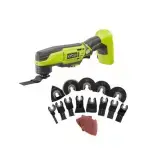 |
Flush cutting in wood and drywall |
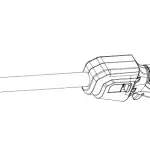 |
Sanding in corners and other hardto-reach areas |
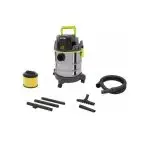 |
Sanding sheets in 60 grit (1), 80 grit (1), and 120 grit (1) are provided for sanding in different applications |
OPERATION
![]() WARNING: Do not wear loose clothing or jewelry when operating this tool. They could get caught in moving parts causing serious injury. Keep head away from tool and work area. Hair could be drawn into tool causing serious injury.
WARNING: Do not wear loose clothing or jewelry when operating this tool. They could get caught in moving parts causing serious injury. Keep head away from tool and work area. Hair could be drawn into tool causing serious injury.
![]() WARNING: Unsecured work could be thrown towards the operator, causing injury.
WARNING: Unsecured work could be thrown towards the operator, causing injury.
![]() WARNING: Keep hands away from blades. Do not reach underneath work or around or over the blade while blade is moving. Do not attempt to remove cut material when blade is moving.
WARNING: Keep hands away from blades. Do not reach underneath work or around or over the blade while blade is moving. Do not attempt to remove cut material when blade is moving.
CUTTING
See Figure 6, page 10.
- Mark the line of cut clearly.
- Hold the tool firmly in front of and clearly away from you. Make sure blade is clear of any foreign material.
- Rotate the variable speed dial counterclockwise to the desired speed setting.
- Depress the switch trigger to start the cutting action. Allow the blade to come to full speed, then move the blade into the work.
- To cut, keep the teeth of the blade in the workpiece surface and move the back of the tool slowly in a constant sideways motion.
NOTE: If the line and writing on the blade looks blurry when in use, you are using the correct amount of pressure. If they become clear, you are using too much force.
NOTICE: Do not force. Use only enough pressure to keep the saw cutting. Let the blade and saw do the work. Use of excessive pressure will cause strong vibrations to the tool, which may result in broken blades and cause premature wear to the tool’s motor.
SANDPAPER SELECTION
Selecting the correct size grit and type of sandpaper is an extremely important step in achieving a high-quality sanded finish. Aluminum oxide, silicon carbide, and other synthetic
abrasives are best for power sanding. Natural abrasives, such as flint and garnet are too soft for economical use in power sanding.
In general, coarse grit will remove the most material and finer grit will produce the best finish in all sanding operations. The condition of the surface to be sanded will determine which grit will do the job. If the surface is rough, start with coarse grit and sand until the surface is uniform. Medium grit may then be used to remove scratches left by the coarser grit and finer grit used for finishing of the surface. Always continue sanding with each grit until the surface is uniform.
SANDING
See Figure 7, page 10.
Hold the sander in front of and away from you, keeping it clear of the workpiece. Start the sander and let the motor build to its maximum speed, then gradually lower on the work with a slight forward movement. Move the sander slowly over the workpiece using forward and backward or side to side strokes. Upon completion of sanding operation, always remove the sander from the workpiece before turning it off.
- Do no t force. The weight of the unit supplies adequate pressure, so let the sandpaper and sander do the work. Applying additional pressure only slows the motor, rapidly wears sandpaper, and greatly reduces sander speed. Excessive pressure will overload the motor causing possible damage from motor overheating and can result in inferior work. Any finish or resin on wood may soften from the frictional heat. Do not allow sanding on one spot too long, as the sander’s rapid action may remove too much material, making the surface uneven.
MAINTENANCE
![]() WARNING:
WARNING:
When servicing, use only identical replacement parts.
Use of any other part could create a hazard or cause product damage.
GENERAL MAINTENANCE
Avoid using solvents when cleaning plastic parts. Most plastics are susceptible to damage from various types of commercial solvents and can be damaged by their use. Use
clean cloths to remove dirt, dust, oil, grease, etc.
ACCESSORIES
Look for these accessories where you purchased this product or call 1-800-525-2579:
- Segment Saw Blade …………………………………………………..681457016
- General Purpose Plunge Cut Blade ………………………..681458028
- Detail Sanding Backing Pad ……………………………………303590006
- Sanding Sheets ………………902460001 (80 Grit), 902423001 (60 Grit), and 902424001 (120 Grit)
WARNING:
Current attachments and accessories available for use with this product are listed above. Do not use any attachments or accessories not recommended by the manufacturer of this product. The use of attachments or accessories not recommended can result in serious personal injury.
TROUBLESHOOTING
LED LIGHT FUNCTIONS
| TOOL STATUS | LED LIGHT SCENARIO | ACTION REQUIRED |
| Normal | Solid Light (No Flashes) | No Action Needed |
| Low Battery | 3 Flashes | Replace Battery |
| Excessive Force | 6 Flashes | Wait 5 Seconds |
| Over Temperature | 9 Flashes | Let Tool Cool Off |
*More than 9 flashes will result in the need to remove the battery and reinsert a few minutes later.
ILLUSTRATIONS START ON PAGE 10 AFTER THE FRENCH AND SPANISH LANGUAGE SECTIONS.
NOTES……….
A – LED light
B – Variable speed dial
C – Switch trigger
D – Hex key
E – Lock-on button
F – Segment saw blade
G – Detail sanding backing pad
H- General purpose plunge cut blade

A – Screw |

A – Battery pack |
SPEED SETTINGS (STANDBY TO HIGH) = 0-6
– Variable speed dial |

A – Switch trigger |

A – General-purpose plunge cut blade |
 |
 |
OPERATOR’S MANUAL/18 VOLT OSCILLATING MULTI-TOOL MANUEL D’UTILISATION/OSCILLANT OUTIL POLYVALENT 18 V
To request service, purchase replacement parts,
locate an Authorized Service Center or obtain Customer or Technical Support:
Visit www.ryobitools.com or call 1-800-525-2579
If any parts or accessories are damaged or missing, do not return this product to the store.
Call 1-800-525-2579 for immediate service.
Please obtain your model and serial number from the product data plate.
This product is covered under a 3-year limited Warranty. Proof of purchase is required.
MODEL NUMBER* _______________ SERIAL NUMBER ____________________________
*Model number on product may have additional letters at the end. These letters designate
manufacturing information and should be provided when calling for service.
RYOBI is a registered trademark of Ryobi Limited and is used pursuant to a license granted by Ryobi Limited.
ONE WORLD TECHNOLOGIES, INC.
P.O. Box 1288, Anderson, SC 29622 • Phone 1-800-525-2579
États-Unis, Téléphone 1-800-525-2579 • USA, Teléfono 1-800-525-2579
www.ryobitools.com
998000591 4-21-21 (REV:03)

